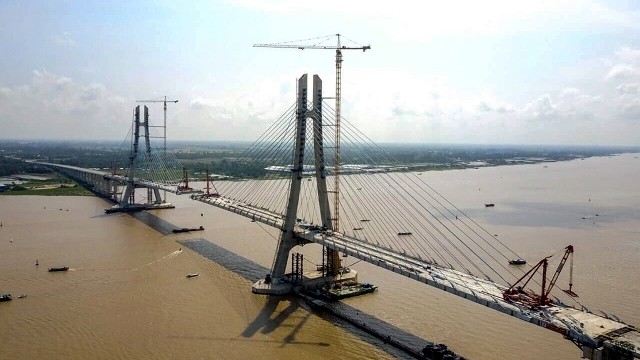Vam Cong, linking Lap Vo district (Dong Thap province) and Thot Not district (Can Tho city), is the largest bridge under a transport connection project linking provinces in the central area of Mekong Delta region. It is also the second bridge after the Can Tho Bridge spanning the Hau River.
Construction on the bridge started in September 2013 and it is designed with a total length of 2.97km, in which the main span is about 870m long. Its main H-shaped pylon measures 143.9m long, designed with a capacity of 5,000 DWT.
The fan-shaped cable-stayed cords consist of 144 wires arranged on two oblique planes. The bridge will have four lanes for motorised vehicles and two lanes for rudimentary vehicles, with a designated speed of 80kph.
With a total investment of nearly US$271 million sourced from preferential ODA funds provided by the Government of Republic of Korea and funds from the Government of Vietnam, the completion of the bridge will contribute to the reduction of Vam Cong ferry’s traffic overload.
Tran Van Thi, General Director of Cuu Long Transportation Infrastructure Project Management & Development Investment Corporation (under the Ministry of Transport), said that Vam Cong Bridge is an important part of Component 3 under the Mekong Delta Regional Transport Linkage project. The component has a total investment of over VND7.3 trillion (US$321.2 million).
 |
Vam Cong’s final segment was installed on Friday morning, linking the two banks of the Hau River in Can Tho city and Dong Thap province. (Credit: NDO)
With the completion of the Vam Cong and Cao Lanh Bridges, as well as the commencement of the construction for Lo Te - Rach Soi Highway, the second axis with four lanes of high speed transport connecting Ho Chi Minh City to Rach Gia city in Kien Giang province has been formed, along with the N2 route.
The completion of the Vam Cong project will help to shorten the travel time from HCM City to localities on the route and vice versa, while meeting the increasing transportation demand and reducing congestion on National Highway No. 1.
It also contributes to improving the regional road network, therefore, consolidating national defence and security, and promoting socio-economic development not only for the Mekong Delta but for the whole of the key southern economic region as well.
The entire project will be completed by Korean and Vietnamese engineers by late 2017. This is the longest span steel bridge in the Mekong Delta.
In early September, the Cao Lanh Bridge crossing the Tien River in Cao Lanh city and Lap Vo district (Dong Thap) also had their final segments installed. The bridge is more than 2km long, consisting of six lanes and the total cost for the project is over VND3 trillion.
Both Vam Cong and Cao Lanh Bridges will be accessible by the end of this year, becoming a driving force for socio-economic development and defence and security in the Mekong Delta.
















